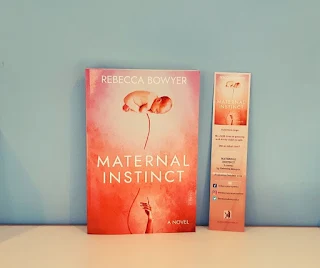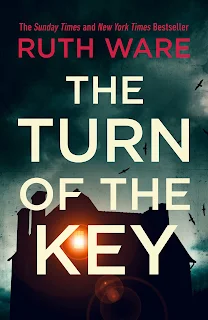 |
| Rebecca Bowyer |
Today I'm welcoming Australian reviewer, book blogger and debut author Rebecca Bowyer to Carpe Librum. Maternal Instinct is coming out next month and I couldn't resist asking Rebecca a few questions. Be sure to enter the giveaway below for your chance to win a copy.
Interview
How long have you been reviewing books at Story Addict?
I've been publishing reviews on
Story Addict for 2 years, but I've been reviewing books on other websites since 2013.
How many books do you review a year and what’s your favourite genre?
I had to look this one up to check! In the past 12 months I've reviewed 57 books. My favourite genre is speculative fiction, which is also what I write. I'm a sucker for anything that imagines what our world might look like in the future. I also love historical and literary fiction with a smattering of contemporary fiction. Plus the occasional memoir.
What made you decide you wanted to be an author?
I wanted to be an author when I was a kid. I always loved to tell stories and was constantly writing fragments on scraps of paper.
In my early 20s I gave up on my dreams completely. I decided NOT to be an author. By then I’d had a short story published in a local literary journal and had attempted to write an angsty romance novel and a pretty terrible fantasy novel. I think I got about 10,000 words in to each and gave up. My primary creative outlet became music. I sang with the Melbourne Symphony Orchestra Chorus and then the West Australian Symphony Orchestra Chorus.
Nearly 10 years later I rediscovered my love of storytelling, this time as a parenting blogger. As a stay-at-home mum on maternity leave, I was increasingly frustrated by the lack of value placed on parenting in our society. My attempts to explain myself were met with comments such as, “But you are valued,” and “Parenting is a privilege”. I needed a way to explain what I meant and I found the best way to do that was to show, rather than tell. So I created a world, in my novel
Maternal Instinct, where parenting is actually fully valued, including in an economic sense.
Once I started writing fiction I found I loved it and wanted to keep going. The genesis of the story was anger and frustration but the characters took on lives of their own and told a story I hadn't foreseen.
Was writing a novel harder or easier than you thought?
Both. While I’m writing and the words are coming and the characters are demanding to be heard, it’s easy. I just type up what they’re telling me. But when life gets louder, or I’m exhausted, it’s harder to find the space to hear them and the time to write it all down.
Do you think it’s an advantage or a disadvantage to have so much experience reviewing before becoming a published author yourself?
Absolutely an advantage. Reviewing forces me to read deliberately and thoughtfully, analysing what it is I do and don't like. It also introduced me to other authors. I highly recommend book reviewing to any budding authors.
 |
| Giveaway prize valued at $29.99AUD |
If you had 30 words to convince a reader to read your book, what would they be?
[Year] 2040: Parenting is a highly valued profession but your own children are taken at 6 months.
Maternal Instinct combines the style of
Big Little Lies with themes similar to
The Handmaid’s Tale.
How has the transition from blogger and reviewer to published author been?
Novel writing is neither better nor worse than any other kind of writing. I don’t see it as a transition. To me, publishing a novel is simply an addition to the other writing I do - reviews, articles, technical, content. It’s simply on a much larger scale and with much, much longer timeframes.
Do you have any literary influences?
Every book I’ve ever read has influenced me, so I’ll say ‘yes’ to this question. I’m not sure I can name just a few influences.
What’s your secret reading pleasure?
As a book blogger, all my reading pleasures are quite public these days. I’m not ashamed of anything I read. I’ve enjoyed everything from Solzhenitsyn to
Twilight. I love great writing but I love immersive stories even more and am happy to overlook less than brilliant prose in favour of a great story.
What are you reading at the moment?
I’ve just finished reading
The Trauma Cleaner, by Sarah Krasnostein. It’s as incredible as everyone says it is.
When I’m not reading, writing, or reviewing I’m…working at my day job as a Digital Experience and Strategy lead. In English that means ‘write good words for websites and make sure they’re all in the right spot’. I’m also spending as time as much time as possible with my young family.
What are your writing or publishing plans for the future?
I’ve almost finished the first draft of my next novel,
Time Thief. Its premise is based on my own fantasy of wanting to be able to literally buy time, especially in the context of being a parent in the paid workforce. How nice would it be, to take a pill that gives you 4 whole hours to yourself, to do whatever you want, without anyone bothering you?
I’ve also had a few requests from readers for a sequel to
Maternal Instinct (for which I am extremely grateful!). I do have a few thousand words started on a sequel, but I’m going to finish
Time Thief before I go back to it.
Thanks so much Rebecca! You can check out Rebecca's website for more info and enter the giveaway below to win a copy of Maternal Instinct along with a complimentary bookmark.
Giveaway
Blurb for Maternal Instinct
Australia 2040. No child lives in poverty and every child is safe. But at what cost?
19-year-old Monica never wanted a baby but the laws require her to give birth twice before she can move on with her life.
Now that her first son, Oscar, has arrived she’s not so sure she wants to hand him over to be raised by professional parents: the Maters and Paters.
When Monica turns to her birth mother, Alice, for help, she triggers a series of events that force Alice to confront her own dark past. Alice must decide – help her daughter break the law, or persuade her to accept her fate and do what’s best for the nation’s children?
This giveaway has now closed and the winner was announced here.










































